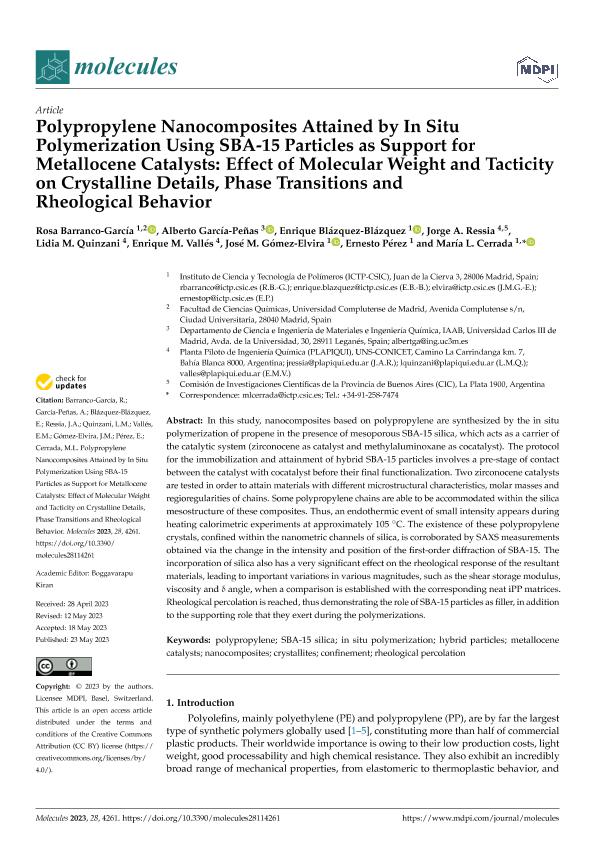Mostrar el registro sencillo del ítem
dc.contributor.author
Barranco García, Rosa
dc.contributor.author
García Peñas, Alberto
dc.contributor.author
Blázquez Blázquez, Enrique
dc.contributor.author
Ressia, Jorge Aníbal

dc.contributor.author
Quinzani, Lidia Maria

dc.contributor.author
Valles, Enrique Marcelo

dc.contributor.author
Gómez Elvira, José M.
dc.contributor.author
Pérez, Ernesto
dc.contributor.author
Cerrada, María L.

dc.date.available
2024-04-30T10:28:14Z
dc.date.issued
2023-06
dc.identifier.citation
Barranco García, Rosa; García Peñas, Alberto; Blázquez Blázquez, Enrique; Ressia, Jorge Aníbal; Quinzani, Lidia Maria; et al.; Polypropylene Nanocomposites Attained by In Situ Polymerization Using SBA-15 Particles as Support for Metallocene Catalysts: Effect of Molecular Weight and Tacticity on Crystalline Details, Phase Transitions and Rheological Behavior; Molecular Diversity Preservation International; Molecules; 28; 11; 6-2023; 1-26
dc.identifier.issn
1420-3049
dc.identifier.uri
http://hdl.handle.net/11336/234232
dc.description.abstract
In this study, nanocomposites based on polypropylene are synthesized by the in situ polymerization of propene in the presence of mesoporous SBA-15 silica, which acts as a carrier of the catalytic system (zirconocene as catalyst and methylaluminoxane as cocatalyst). The protocol for the immobilization and attainment of hybrid SBA-15 particles involves a pre-stage of contact between the catalyst with cocatalyst before their final functionalization. Two zirconocene catalysts are tested in order to attain materials with different microstructural characteristics, molar masses and regioregularities of chains. Some polypropylene chains are able to be accommodated within the silica mesostructure of these composites. Thus, an endothermic event of small intensity appears during heating calorimetric experiments at approximately 105 °C. The existence of these polypropylene crystals, confined within the nanometric channels of silica, is corroborated by SAXS measurements obtained via the change in the intensity and position of the first-order diffraction of SBA-15. The incorporation of silica also has a very significant effect on the rheological response of the resultant materials, leading to important variations in various magnitudes, such as the shear storage modulus, viscosity and δ angle, when a comparison is established with the corresponding neat iPP matrices. Rheological percolation is reached, thus demonstrating the role of SBA-15 particles as filler, in addition to the supporting role that they exert during the polymerizations.
dc.format
application/pdf
dc.language.iso
eng
dc.publisher
Molecular Diversity Preservation International

dc.rights
info:eu-repo/semantics/openAccess
dc.rights.uri
https://creativecommons.org/licenses/by/2.5/ar/
dc.subject
CONFINEMENT
dc.subject
CRYSTALLITES
dc.subject
HYBRID PARTICLES
dc.subject
IN SITU POLYMERIZATION
dc.subject
METALLOCENE CATALYSTS
dc.subject
NANOCOMPOSITES
dc.subject
POLYPROPYLENE
dc.subject
RHEOLOGICAL PERCOLATION
dc.subject
SBA-15 SILICA
dc.subject.classification
Otras Ingeniería de los Materiales

dc.subject.classification
Ingeniería de los Materiales

dc.subject.classification
INGENIERÍAS Y TECNOLOGÍAS

dc.title
Polypropylene Nanocomposites Attained by In Situ Polymerization Using SBA-15 Particles as Support for Metallocene Catalysts: Effect of Molecular Weight and Tacticity on Crystalline Details, Phase Transitions and Rheological Behavior
dc.type
info:eu-repo/semantics/article
dc.type
info:ar-repo/semantics/artículo
dc.type
info:eu-repo/semantics/publishedVersion
dc.date.updated
2024-04-23T13:36:58Z
dc.journal.volume
28
dc.journal.number
11
dc.journal.pagination
1-26
dc.journal.pais
Suiza

dc.journal.ciudad
Basilea
dc.description.fil
Fil: Barranco García, Rosa. Instituto en Ciencia y Tecnología de Polímeros; España. Universidad Complutense de Madrid; España
dc.description.fil
Fil: García Peñas, Alberto. Universidad Carlos III de Madrid. Instituto de Salud; España
dc.description.fil
Fil: Blázquez Blázquez, Enrique. Instituto en Ciencia y Tecnología de Polímeros; España
dc.description.fil
Fil: Ressia, Jorge Aníbal. Consejo Nacional de Investigaciones Científicas y Técnicas. Centro Científico Tecnológico Conicet - Bahía Blanca. Planta Piloto de Ingeniería Química. Universidad Nacional del Sur. Planta Piloto de Ingeniería Química; Argentina. Provincia de Buenos Aires. Gobernación. Comisión de Investigaciones Científicas; Argentina
dc.description.fil
Fil: Quinzani, Lidia Maria. Consejo Nacional de Investigaciones Científicas y Técnicas. Centro Científico Tecnológico Conicet - Bahía Blanca. Planta Piloto de Ingeniería Química. Universidad Nacional del Sur. Planta Piloto de Ingeniería Química; Argentina
dc.description.fil
Fil: Valles, Enrique Marcelo. Consejo Nacional de Investigaciones Científicas y Técnicas. Centro Científico Tecnológico Conicet - Bahía Blanca. Planta Piloto de Ingeniería Química. Universidad Nacional del Sur. Planta Piloto de Ingeniería Química; Argentina
dc.description.fil
Fil: Gómez Elvira, José M.. Instituto en Ciencia y Tecnología de Polímeros; España
dc.description.fil
Fil: Pérez, Ernesto. Instituto en Ciencia y Tecnología de Polímeros; España
dc.description.fil
Fil: Cerrada, María L.. Instituto en Ciencia y Tecnología de Polímeros; España
dc.journal.title
Molecules

dc.relation.alternativeid
info:eu-repo/semantics/altIdentifier/url/https://www.mdpi.com/1420-3049/28/11/4261
dc.relation.alternativeid
info:eu-repo/semantics/altIdentifier/doi/http://dx.doi.org/10.3390/molecules28114261
Archivos asociados
